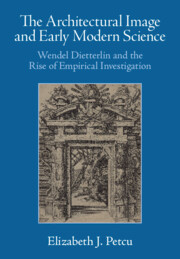 The Architectural Image and Early Modern Science
The Architectural Image and Early Modern Science Published online by Cambridge University Press: 29 November 2024
The legacy of Dietterlin’s Architectura is evident in the enduring role of empiricism across seventeenth-century architecture and natural philosophy. The Architectura served as the culmination of a breed of architectural image-making informed by the humanistic philosophy of learned empiricism, which intertwined the iconography of the fantastical and the occult with empirical ideas and practices. The decline of learned empiricism’s influence over architectural images is already anticipated in Dürer’s Melencolia I, which inspired the final etching of Dietterlin’s Architectura as an elegy to that tradition. Dietterlin’s contributions to the consolidation of architectural images as platforms for empirical scientific inquiry, as well as the waning of learned empiricism, resonated in seventeenth-century England and France, where architectural images eschewed symbolic representations for a novel visuality that foregrounded purely empirical evidence. Dietterlin’s Architectura catalyzed the new relationship between architecture and science by exposing the limits of humanist symbolism and the vast potential of architectural images as agents of empirical thinking, philosophy, and practices.
To save this book to your Kindle, first ensure [email protected] is added to your Approved Personal Document E-mail List under your Personal Document Settings on the Manage Your Content and Devices page of your Amazon account. Then enter the ‘name’ part of your Kindle email address below. Find out more about saving to your Kindle.
Note you can select to save to either the @free.kindle.com or @kindle.com variations. ‘@free.kindle.com’ emails are free but can only be saved to your device when it is connected to wi-fi. ‘@kindle.com’ emails can be delivered even when you are not connected to wi-fi, but note that service fees apply.
Find out more about the Kindle Personal Document Service.
To save content items to your account, please confirm that you agree to abide by our usage policies. If this is the first time you use this feature, you will be asked to authorise Cambridge Core to connect with your account. Find out more about saving content to Dropbox.
To save content items to your account, please confirm that you agree to abide by our usage policies. If this is the first time you use this feature, you will be asked to authorise Cambridge Core to connect with your account. Find out more about saving content to Google Drive.